Weaving Textiles
By the end of the 19th century, twined mountain goat wool robes were gradually being replaced by commercial cloth. But in the 20th century, the old techniques were revived and many contemporary weavers of today make garments for ceremonial use and for participants in canoe journeys. Due to the difficulty in acquiring traditional materials today, most Coast Salish weavers use domestic sheep wool.
Lummi weavers, the late Fran James (1924-2013) and her son, Chief Bill James (Tsi'li'xw), revived spinning and weaving on the Lummi Reservation during the last half of the 20th century. Fran adapted an electrical machine to speed her spinning process.
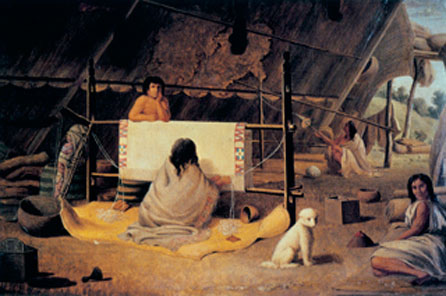
During the 18th and 19th centuries, women used the wool of mountain sheep as well as dog wool sheared from small “wooly” dogs.

A woman named Selisya spinning wool, photographed at the Coast Salish village of Musqueam by C. F. Newcombe in 1915.
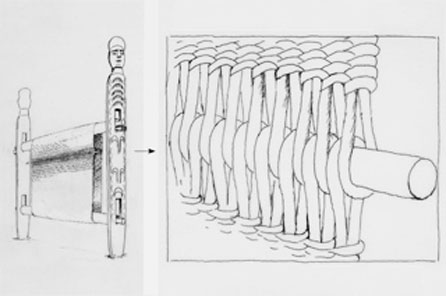
Looms have two support posts and two rolling bars set into slots. The yarn is tied to a smaller bar and looped up, down and around the rolling bars, then wrapped around the third bar, reversing the direction until the desired width is achieved. Finally, the warp ends are released and the robe is removed.
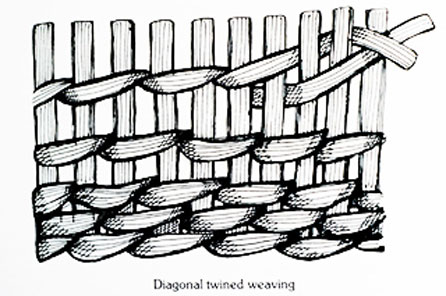
Weaving is done with only the fingers. Plaiting is done with one horizontal weft yarn passing in front and behind the vertical warp yarns. Twining is done with two horizontal weft yarns one passing in front while the other passes behind the warp. This technique can be used to create a tighter weave and allows for elaborate geometric patterns to be created.
Weaving Cattail Mats
Coast Salish women sewed cattail leaves together to form large mats that were used as room dividers, insulation, kneeling pads in canoes, sleeping mats, and temporary shelters. The leaves are laid out in parallel rows, and two tools, a mat creaser and a mat needle were used to pierce the leaves and pull a cattail thread through the hole to bind together the leaves. The mat creaser is pressed along the long needle when it is in the leaves, to form a crease that serves to hold the thread in place. The edges are braided.
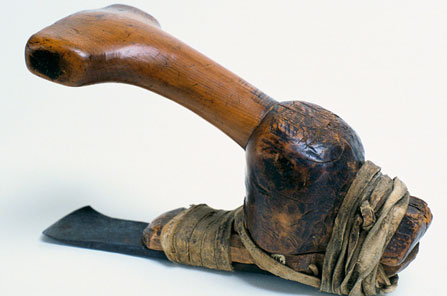
Coast Salish woman sewing a cattail mat at Sand Spit, Camano Island near Stanwood, WA.

Snohomish cattail mat, Tulalip Reservation, collected by Erna Gunther, 1930, Burke Museum cat. no. 1-10827.
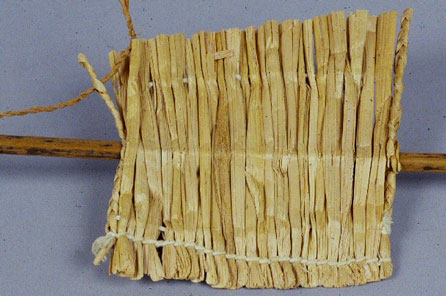
Sooke cattail mat section with mat needle inserted, Burke Museum cat. no. 1-2077.
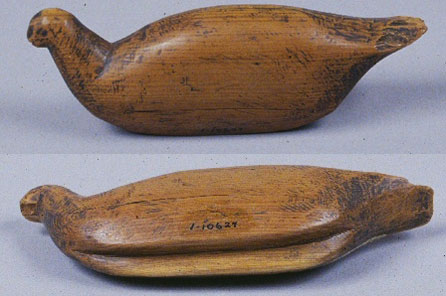
Saanich mat creaser, Burke Museum cat. no. 1-10627.
Weaving Basketry
Baskets were used for storage or for gathering berries, roots, clams and other foods. Coiled baskets were tight enough to be used for boiling soups and stews. There are three basic basketry techniques used by Coast Salish weavers: coiling, twining and plaiting.
For coiled baskets, cedar roots are peeled and split. The rough inner roots are bundled to make the foundation of the coil, and the smooth outer root is used as the sewing element. Coiling involves the use of an awl, a pointed bone tool, to push a hole through the coil below the bundle, the sewing element is pushed through this opening and tightened to attach the bundle to the coil below. Decorative elements made of cherry bark, dyed cedar bark, bear grass, or horsetail rhizomes, are folded and sewn down on the outside of the basket to form geometric patterns, in a technique called imbrication.
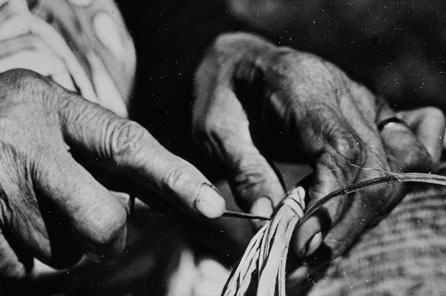
Mrs. Julia Siddle, Duwamish of the Muckleshoot Reservation, using an awl to make a coiled cedar root basket.
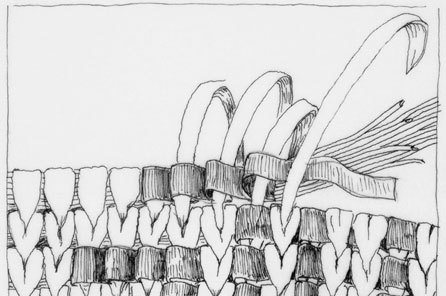
Coiling and imbrication diagram, Drawing by Kenneth Greg Watson, 2008 (Brotherton 2008: Fig. 9.4, p. 200).
The twining technique, also used in loom-weaving, involves two wefts (horizontal weaving elements) that cross in front and behind the vertical warps that form the foundation of the basket. Materials used in twined baskets include cattail leaves, cedar bark, and spruce roots. Designs are formed by overlaying a dyed weft or using wefts of different colors. Twined baskets are softer and more pliable than coiled baskets.
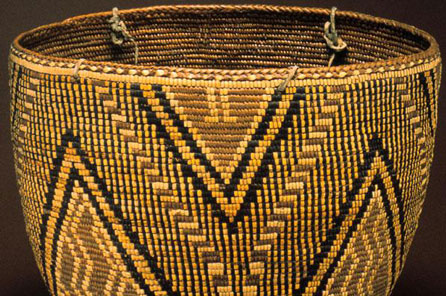
This coiled cedar root basket was made by Mrs. Siagut and collected by Judge Wickersham in 1899. (Burke Museum cat. no. 2005-21/1).

This basket displays both plaiting and twining techniques. Split cedar bark is used with an overlay of grass, giving a rich appearance to this utility storage basket. The looped rim could be used to tie a cloth cover over the contents of the basket. Twill plaited and twined cedar bark and grass basket made by Mary Josh, Sauk-Siuattle, Burke Museum cat. no. 1-308.

Illustration: Kenneth Greg Watson, 2008.

Open-work baskets like this one were made of pealed cedar roots twined with split cedar strips. They were attached to woven tumplines, used as head or shoulder straps, and filled with clams that could be rinsed, allowing the sandy water to run out. Coast Salish Clam basket with woven tumpline, collected by the Young Naturalists Society, 1904, Burke Museum cat. no. 415.
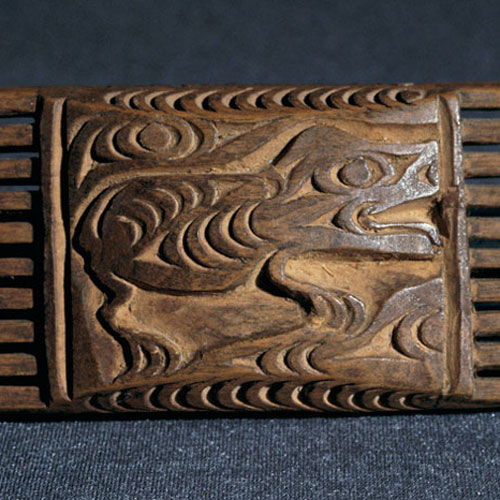
See More Coast Salish Art
Continue exploring the history of art in this region, what makes Coast Salish art distinctive among the many regional Northwest Coast styles, and the vitality of contemporary Coast Salish art.
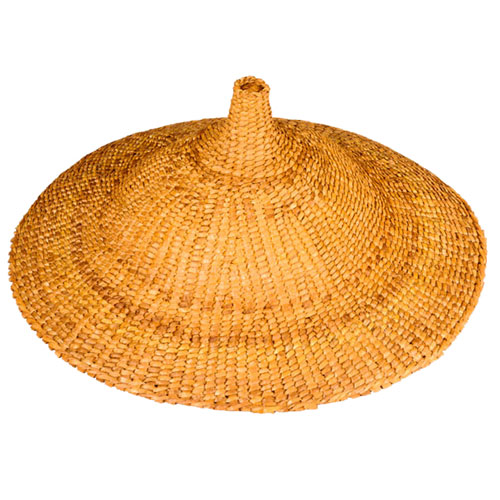
Additional Coast Salish Art Resources
Search additional resources related to the First Peoples who speak the Coast Salish language.
